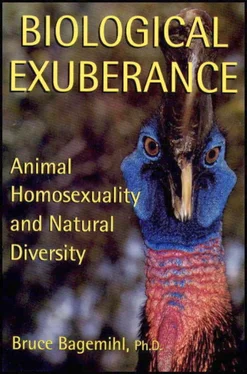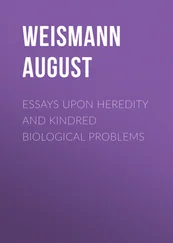A group of male Walruses off the coast of Round Island (Alaska). Pairs of males are participating in courtship and other activities with each other while floating in the water. Male Walruses are often seasonally bisexual, engaging in homosexual pursuits outside the breeding season.

Simultaneous bisexuality also assumes many guises. At one extreme, sexual activity with same-sex and opposite-sex partners takes place at literally the same time: “pile-up” copulations, for example, in which a male mounts another male who is mounting a female (e.g., Wolves, Laughing Gulls, Little Blue Herons), or group sexual activity in which some or all participants are interacting with both males and females (e.g., Bonobos, West Indian Manatees, Common Murres, Sage Grouse). At the other extreme, individuals court or mate with both sexes separately, over short but relatively distinct spans of time, as in Crab-eating Macaques, Mountain Goats, Redshanks, and Anna’s Hummingbirds. In between these extremes are other patterns, such as ongoing bisexual trios and quartets, in which both same-sex and opposite-sex partners are bonded to one another concurrently (e.g., Greylag Geese, Oystercatchers, Jackdaws). Another form of simultaneity involves an animal in a pair-bond with a member of the opposite sex who has occasional courtship and/or sexual encounters with a member of the same sex (or vice versa). For example, male Herring and Laughing Gulls, Herons, Swallows, and Common Murres who have female partners, and female Mallard Ducks who have male partners, sometimes mount birds of the same sex. Conversely, female Snow Geese, Western Gulls, and Caspian Terns and male Humboldt Penguins and Laughing Gulls who have same-sex partners sometimes mate with opposite-sex partners. Still another variation is found in Lesser Flamingos: males in homosexual pairs sometimes try to mate with females who are themselves in homosexual pairs. And in some animals such as Bottlenose Dolphins, Black-headed Gulls, and Galahs, the combinations are even more varied: different forms of sequential and simultaneous bisexuality, as well as exclusive homosexuality (and heterosexuality) are found in different individuals within the same species and may even combine in the same individual at different points in time.
Even within a given category of bisexuality—say, simultaneous bisexuality involving interspersed homosexual and heterosexual activity—each individual within a population generally exhibits a unique sexual orientation profile, consisting of his or her own particular combination of same- and opposite-sex activity. The concept of a scale or continuum as developed by Alfred Kinsey for describing human sexual orientation is useful here: within each species, individuals generally fall along a range from those exhibiting predominantly or exclusively heterosexual behavior, to those exhibiting a balance of both, to those exhibiting predominantly or exclusively homosexual behavior, and every variation in between. 20Species as a whole also differ as to where the majority of individuals fall along this continuum, and how many engage in more exclusive homosexuality or heterosexuality as opposed to more equal bisexuality. Thus, among Bonobos every female participates in both homosexual and heterosexual activity, but the proportion of same-sex behavior exhibited by each of the females in one particular troop varied between 33 percent and 88 percent (averaging 64 percent); in female Red Deer, from 0–100 percent (averaging 49 percent); among Bonnet Macaque males, between 12 percent and 59 percent (averaging 28 percent); in male Pig-tailed Macaques, from 6–22 percent (averaging 18 percent); and among Kob females, from 1–58 percent (averaging 11 percent). 21In other words, within an overall pattern of bisexuality, individual animals exhibit varying “degrees” of bisexuality—different “preferences,” as it were, for homosexual as opposed to heterosexual activity.
These findings are particularly relevant since the concept of a scale or continuum of (homo)sexual behavior and orientation is yet another example of something still thought to be “uniquely human.” The Bonobo data (as well as that for the other species) directly refute one primatologist’s recent claim that “all wild primates we have seen within a particular species are equally homosexual…. If you lined up ten female bonobos, it’s not like one would be a 6 on the Kinsey scale and another a 2. They would all be the same number. It’s only humans who adopt identities.” 22Of course, the Kinsey scale is specifically a measure of behaviors and not identities (it was designed expressly to bypass the often problematic issue of people’s “self-identification”), and certainly no animal studies purport to assess anything as subjective as sexual “identity.” In its intended usage, though, the Kinsey scale (or a comparable measure of sexual gradations) in fact appears to be particularly apt for Bonobos. The figures cited above are based on the work of Dr. Gen’ichi Idani in Congo (Zaire), who studied a troop consisting of (coincidentally) exactly ten female Bonobos and tabulated all their homosexual genital rubbings versus heterosexual copulations over a three-month period. The percentages of homosexual activity in these individuals were 33, 36, 47, 68, 68, 70, 75, 75, 82, and 88 percent. Idani also tabulated the number of different male and female partners of each female (another possible measure of degree of bisexuality or behavioral “preference”). Again, the percentage of partners that were same-sex exhibits a range across all females: 36, 50, 50, 54, 67, 67, 67, 69, 71, and 80 percent. Clearly these individuals fall into a spectrum in terms of their sexual behavior and thus exhibit different degrees of bisexuality in terms of their sexual orientation (although none are in fact exclusively heterosexual or homosexual). 23
“Preference” for same-sex activity is, admittedly, a rather elusive concept to measure when dealing with nonhumans (though not nearly as slippery as “identity”). Although we cannot access their internal motivations or “desires,” animals do offer a number of other clues as to their individual “preferences” in addition to the proportion of their behaviors or partners that are same-sex. These include homosexual activity being performed in (spite of) the presence of members of the opposite sex, individuals actively competing for the attentions of same-sex partners (rather than “resorting” to such activity), advances of opposite-sex partners being ignored and/or refused, and “widowed” or “divorced” individuals continuing to pair with same-sex partners after the loss of a homosexual mate (even when opposite-sex partners are available). These types of behaviors have in fact been reported in more than 50 mammals and birds (see the profiles for some examples), indicating that for at least some individuals in these species, same-sex activity has “priority” over opposite-sex activity in some contexts. The converse is also true for species such as Canada Geese, Silver Gulls, Bicolored Antbirds, Jackdaws, and Galahs: in situations where opposite-sex partners are not available, only a fraction of the population engages in same-sex activity, indicating more of a heterosexual “preference” in the remainder of the population. 24Animals who do participate in same-sex activity in such a situational context could perhaps be said to exhibit a “latent” bisexuality; i.e., a predominantly heterosexual orientation with the potential to relate homosexually under certain circumstances. Another factor to be considered when evaluating individual “preferences” or degrees of bisexuality is the consensuality of the sexual interaction. Female Canada Geese and Silver Gulls in homosexual pairs, for example, may engage in occasional heterosexual copulations under duress; i.e., they are sometimes forcibly mated or raped by males. Likewise, heterosexually paired males in Common Murres, Laysan Albatrosses, Cliff Swallows, and several Gull species may be forcibly mounted by other males. Technically, all such individuals are “bisexual” because they engage in both homosexual and heterosexual activity, but the sort of bisexuality they exhibit is far different from that of a female Bonobo or a male Walrus, for instance, who willingly mates with animals of both sexes.
Читать дальше













